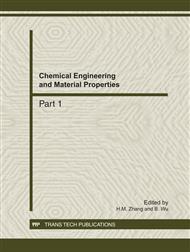p.427
p.432
p.437
p.442
p.447
p.452
p.457
p.462
p.467
Study on Hydration Resistance Property of Gehlenite-Forsterite Refractory Material
Abstract:
The hydration resistance of gehlenite-forsterite refractory material has been studied. The results show that the sample hydrated for 72h have no obvious cracks or deformation and gets a maximum weight increasing ratio of 0.073%. It suggests that it has excellent hydration resistance property. Before being hydrated, the main phases are C2AS and M2S; after being hydrated for 72h, the main phases is not changed, while the diffraction peaks slightly shift to left. With the increase of the hydration time, surface morphology change greatly. During the course of hydration, firstly, the surface attachments are sheded from the surface, the matrix is exposed; secondly, the stick big grains are generated; thirdly, the mesh grains are formed; finally, hydration products fell off or dissolved, and a new course starts.
Info:
Periodical:
Pages:
447-451
Citation:
Online since:
December 2011
Authors:
Price:
Сopyright:
© 2012 Trans Tech Publications Ltd. All Rights Reserved
Share:
Citation:


